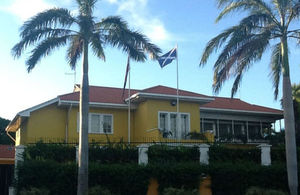St Andrew's Day Celebrated in Tanzania
Scottish people all over the world, including in Tanzania, celebrate St Andrew's Day on 30 November.

Saltire flown at the High Commissioner's Residence
To mark the day the British High Commissioner in Dar es Salaam will fly the Saltire, Scotland’s flag.
Celebrating St Andrew’s Day
St Andrew’s Day is celebrated in Scotland on 30 November, in honour of St Andrew, the patron saint of Scotland. It is Scotland’s official national day. In 2006, the Scottish Parliament designated St Andrew’s Day as a bank holiday. It is also a national holiday in Romania.
St. Andrew was one of Christ’s twelve apostles. Some of his bones are said to have been brought to what is now St. Andrews in Fife during the 4th century. Since medieval times the X-shaped saltire cross upon which St. Andrew was supposedly crucified has been the Scottish national symbol. Although most commonly associated with Scotland, at least in the English-speaking world, Saint Andrew is also the patron saint of Greece, Romania, Russia, Ukraine, the Ecumenical Patriarchate of Constantinople and Saint Andrew, Barbados.
The celebration of St Andrew as a national festival, thought to originate from the reign of Malcolm III (1034 - 1093). But it is only in more recent times that the 30 November has been given national holiday status.
In Scotland, and many countries with Scottish connections, St Andrew’s Day is marked with a celebration of Scottish culture with traditional Scottish food, music and dance. Schools across Scotland hold special St Andrew’s Day events and activities including art shows, Scottish country dancing, lunchtime ceilidhs, dance festivals, storytelling, reciting and writing poems, writing tall tales, cooking traditional Scottish meals, and bagpipe-playing. The day is also seen as the start of a season of Scottish winter festivals encompassing St Andrew’s Day, Hogmanay and Burns Night.
The Saltire
The Saltire is the national flag of Scotland and, with a white diagonal cross on a blue background. Saint Andrew is said to have been martyred on such a cross. In the Russian Orthodox tradition, the phrase Saint Andrew’s Cross is often equated with the Orthodox cross, because of the tradition that Saint Andrew used such a cross when preaching in the respective regions.The saltire design is however distinct from that of the Orthodox Cross.
Believed to be the oldest flag in Europe, the origin of the flag comes from an old legend. Tradition has it that the flag originated in a battle fought near the East Lothian village of Athelstaneford in AD 832.
An army of Picts and Scots under King Angus invaded the Lothians (at that time still Northumbrian territory), and found itself surrounded by a larger force of Saxons led by Athelstan. Fearing the outcome, King Angus led prayers for deliverance and was rewarded by seeing a cloud formation of a white Saltire against the blue sky.
The king vowed that if, with the saint’s help, he gained victory, then Andrew would thereafter be the patron saint of Scotland. The Scots did win, and the Saltire eventually became the flag of Scotland.